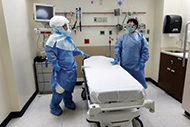It was only a few short months ago that the Ebola virus seemed a distant and remote threat to American health care facilities. Then, the first confirmed Ebola virus disease case (http://www.cdc.gov/media/releases/2014/s930-ebola-confirmed-case.html) was diagnosed in the United States on Sept. 28.
The patient, who was placed in isolation at Texas Health Presbyterian Hospital Dallas, had returned from a trip to Liberia. After initially not showing any symptoms of Ebola, the man sought care on Sept. 26.
This single case has suddenly brought home the potential and real threat this disease can pose to health care facilities, other patients and staff when a person suspected or known to have the disease presents in the patient population. It also underscores the need for environmental services (ES) leaders to remain current on the latest guidance and information from public health authorities on how to respond if a case of Ebola presents in your care setting.
If you haven't already accessed some of the many resources available to assist your team in prevention efforts or to ensure that you haven’t overlooked any important documents, these are some important sites to visit.
• The Centers for Disease Control and Prevention: http://www.cdc.gov/vhf/ebola/hcp/index.html (includes a detailed hospital checklist for Ebola preparedness); and http://www.cdc.gov/vhf/ebola/pdf/healthcare-provider-checklist-for-ebola.pdf (a checklist for hospital personnel)
• The Association for the Healthcare Environment: http://www.ahe.org/ahe/learn/ebola_reference.shtml?utm_source=MagnetMail&utm_medium=email&utm_term=dbarbetta@aha.org&utm_content=October%202014%20Ebola%20blast&utm_campaign=Ebola%20Reference%20Guide#.VDwEv-caaJp (includes information and links on waste handling, textiles and cleaning cloths, webinar recording on Ebola preparedness)
• The Association for Professionals in Infection Control and Epidemiology: http://apic.org/Professional-Practice/Practice-Resources/Ebola-virus-disease (resources on Ebola virus disease)
• The Society for Healthcare Epidemiology of America: http://www.shea-online.org/View/ArticleId/301/Ebola-Infection-Control-Resources.aspx (Ebola infection control resources)
• The World Health Organization: http://www.who.int/csr/resources/publications/ebola/en/ (information resources on Ebola virus disease)
• The American Hospital Association: http://www.aha.org/advocacy-issues/emergreadiness/ebola.shtml#.VCwN2vhJRE4.twitter (Ebola preparedness resources)
Any emergent disease presents a threat to patient, staff and visitor safety and special challenges for ES teams and their leaders. Ebola virus disease is certainly no different in that regard. By working together with infection control and prevention specialists, epidemiologists and public health agencies, ES leaders can play a vital role in ensuring that the Ebola virus threat is minimized.





